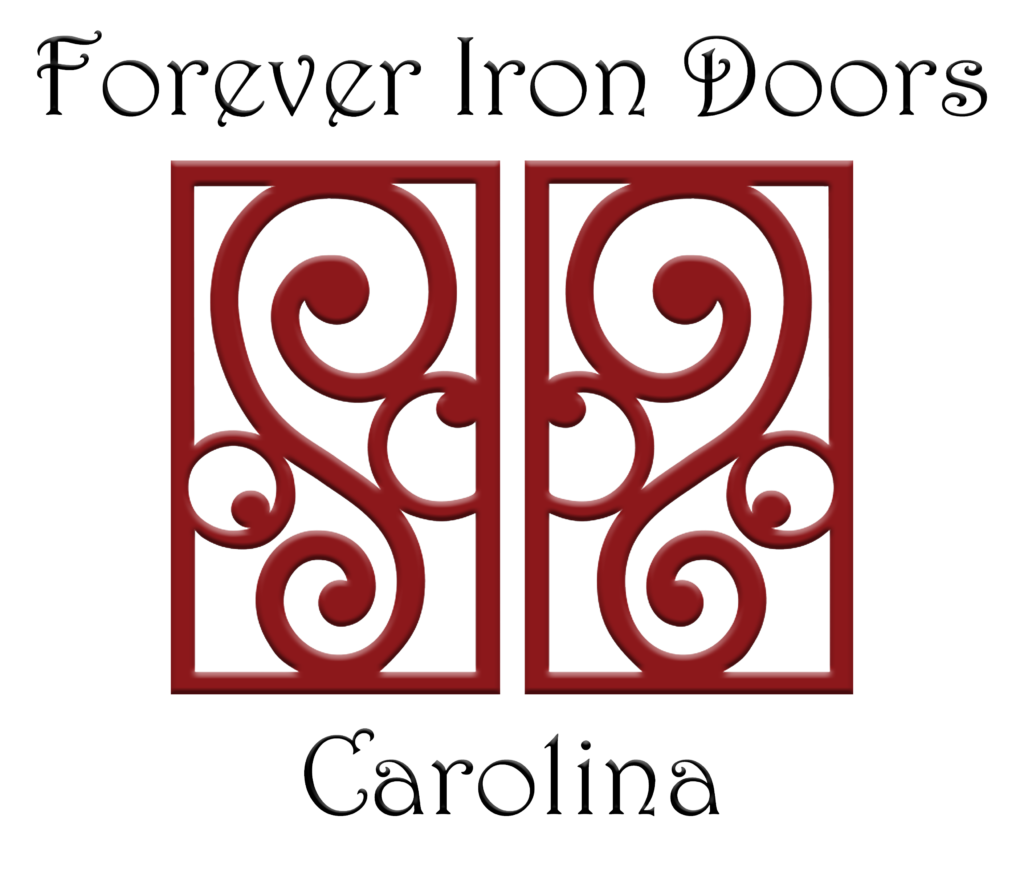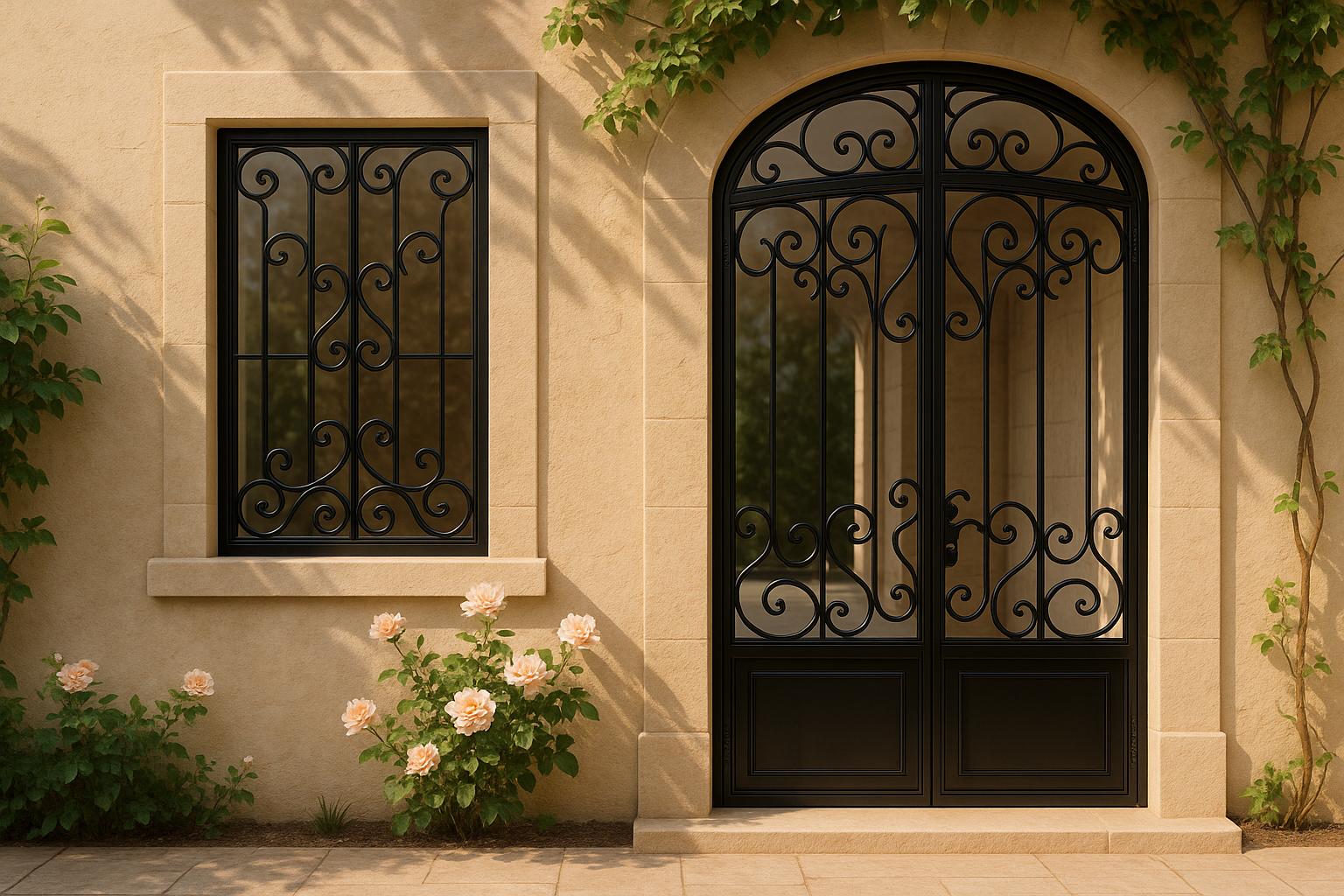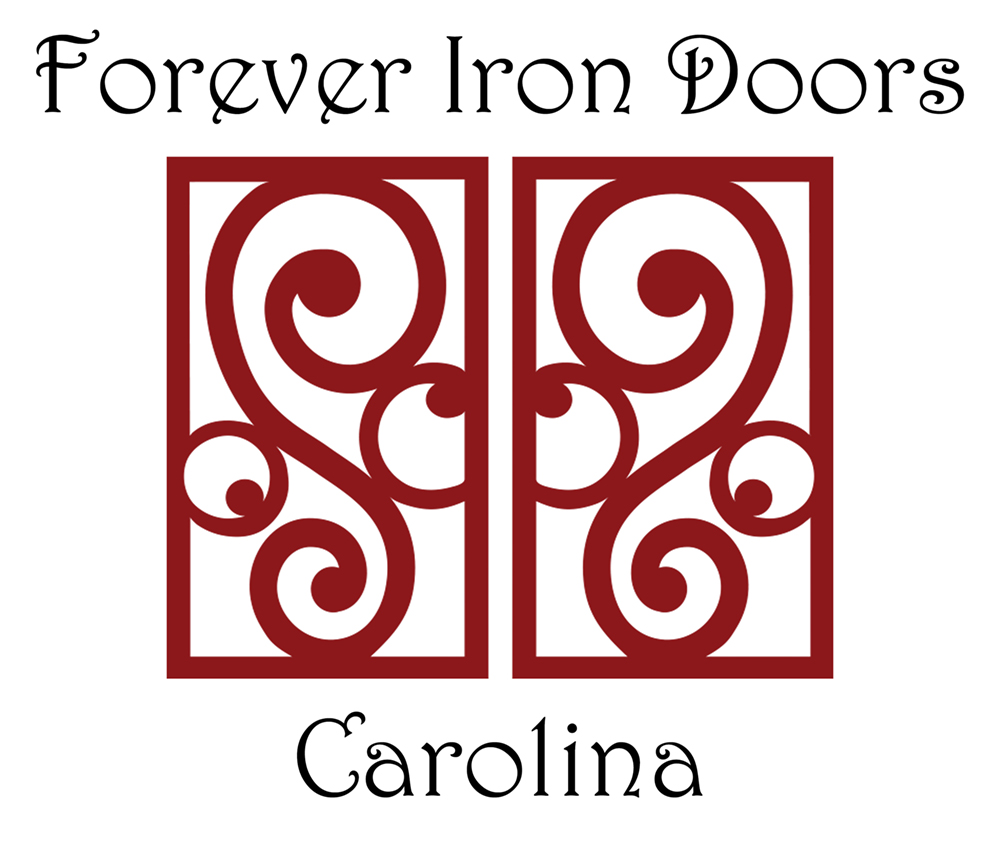Wrought iron windows and doors can last decades, but only if you maintain them properly. Without care, they can rust, weaken, or lose their charm. Here’s what you need to know:
- Clean regularly: Use mild soap and water, and dry thoroughly to prevent rust.
- Prevent rust: Apply protective coatings like primers or waxes, especially in humid or coastal areas.
- Repair promptly: Address scratches, chips, or rust spots early to avoid costly fixes later.
- Inspect frequently: Check monthly for damage and lubricate hinges every 3-4 months.
- Seasonal care: Adjust cleaning and protection based on weather and environment.
How to Clean Wrought Iron Surfaces
Keeping your wrought iron windows and doors in good shape starts with proper cleaning. A gentle cleaning routine not only removes dirt and grime but also helps maintain the protective finish. Here’s how you can clean wrought iron surfaces effectively without risking damage.
Daily and Weekly Cleaning Methods
For regular cleaning, mix water with a vegetable-based soap to create a mild, non-abrasive solution that’s safe for the iron’s protective coating. Use a lint-free cloth to wipe the surface, working from top to bottom. Avoid using harsh materials like steel wool, which could scratch the finish.
Once you’ve washed the surface, rinse it thoroughly with a garden hose to remove any soap residue, as leftover soap can attract dirt over time. After rinsing, make sure to dry the surface completely to prevent rust. A clean towel or dry sponge works well for this, especially around joints, corners, and horizontal sections where water tends to collect.
"Ensure every part of the door is evenly dry because the remaining water on your door can trigger rusting." – Black Diamond Iron Doors
How often you should clean depends on your surroundings. Homes in dusty areas or near busy roads may require weekly cleaning, while homes in less polluted environments can often manage with bi-weekly attention. If you live near the coast, salt exposure makes more frequent cleaning essential.
Once you’ve handled the basics, it’s time to tackle the intricate parts of the design.
Cleaning Detailed Designs and Hard-to-Reach Spots
Wrought iron often features detailed designs that can trap dirt and debris. For these tricky areas, small nylon detail brushes are ideal. Dip the brush in soapy water and gently scrub spots where dirt or chipped paint has built up. An old toothbrush can also come in handy for tight spaces and decorative elements, as its soft bristles are gentle on the finish.
For stubborn debris stuck in crevices, try using a can of compressed air to blow out particles without touching the surface. A garden hose with moderate pressure can also help rinse away loosened dirt from intricate areas. Adjust the nozzle to a gentle spray to avoid forcing water into joints.
Before moving on to any additional maintenance, ensure the surface is completely dry.
How to Prevent Rust and Apply Protective Coatings
Rust forms when iron reacts with moisture and oxygen, a process that worsens in environments rich in salt, sulfur dioxide, or carbon dioxide. Moisture can infiltrate even the tiniest gaps in metal surfaces, making protective coatings a must for long-term preservation.
"Rust is the primary threat to outdoor metalwork. When iron or steel is exposed to moisture and oxygen, it undergoes a chemical reaction that forms iron oxide, or rust." – This Old House
Before applying any protective coating, proper surface preparation is critical. Start by cleaning the surface to remove dirt, grease, and old paint. Tools like wire brushes, sandblasters, or chemical cleaners work well for this task. Make sure to eliminate all traces of rust using sanding, a wire brush, or a rust remover. Once cleaned, ensure the surface is completely dry to avoid trapping moisture under the coating.
After cleaning, sand the metal with fine-grit sandpaper to create a smooth surface for the primer. For intricate designs or hard-to-reach areas, try using a drill with a wire brush attachment or smaller pieces of sandpaper.
How to Apply Protective Coatings
Once the surface is prepped, choose a protective coating that matches the environmental conditions your metalwork will face. Options like epoxy, polyurethane, zinc-rich primers, or powder coating are known for their durability.
"Powder coating is the go-to for many metal products and components to prevent rust and enhance durability." – Palm City Ironworks
Begin by applying a primer to improve adhesion and protect against corrosion. For detailed designs with crevices or joints, spray paint works well to reach areas that brushes might miss. Another option is Nyalic, a thin-film, solvent-borne resin that can be applied directly to ironwork or over existing paint and galvanized surfaces. This clear coating preserves the appearance of wrought iron while providing a strong protective barrier.
How to Fix Scratches and Exposed Areas
Scratches and chips can quickly lead to rust if left untreated. Even minor damage exposes bare metal to moisture and oxygen, triggering corrosion. To repair these areas, start by removing any rust with sandpaper or a wire brush. Clean and dry the surface, then apply a primer followed by matching paint to restore the protective layer.
Inspect your wrought iron regularly – about once a month – for signs of damage. Addressing chips or scratches promptly can prevent small issues from turning into costly restoration projects.
Extra Care for Coastal and Humid Areas
If you live in a coastal or humid environment, your wrought iron faces extra challenges due to higher moisture levels and salt exposure. Airborne pollutants like sulfur dioxide can also accelerate rusting by forming acids when combined with water.
To combat these conditions, clean your wrought iron more frequently using mild soap and water, and make sure to dry it thoroughly after each wash. Apply rust-inhibiting primers and paints more often to maintain a strong protective barrier. Between major coating applications, use protective waxes or clear sealants to keep moisture out.
During severe weather, consider using weatherproof covers to shield your wrought iron from rain and snow. At the start of each season – especially before winter – add extra protective treatments to prepare for increased moisture. Coastal installations require even closer attention; inspect every few weeks and address any rust or damage immediately with fresh paint or sealant. These steps will help preserve both the appearance and strength of your wrought iron in harsh environments.
Setting Up a Regular Maintenance Schedule
Keeping up with regular maintenance is essential to avoid expensive repairs and to ensure your wrought iron lasts for decades – potentially 60–100 years, or even longer in dry climates. The secret? Consistency. Routine care helps you catch small problems before they turn into major headaches.
Your maintenance schedule should reflect your local climate. If you live in coastal or humid areas, you’ll need to perform upkeep more frequently than those in drier regions. Below are key monthly and seasonal tasks to keep your wrought iron looking its best.
Monthly and Seasonal Inspections
Clean your wrought iron monthly using mild soap and warm water with a soft sponge or microfiber cloth. During pollen-heavy seasons or after storms, you might need to clean bi-weekly to prevent debris from trapping moisture. Avoid harsh chemicals like ammonia or bleach, as they can damage protective coatings.
While cleaning, inspect for signs of wear, such as rust stains, pitting, or blistered paint. Spotting these early can save you from costly repairs down the line.
Every three months, take a closer look. Examine all surfaces for rust, and if you find any, gently sand it away with fine-grit sandpaper. Once cleaned, apply a rust converter or a rust-inhibiting primer, then touch up the area with matching paint.
For moving parts like locks and hinges, lubricate them every 3–4 months with silicone spray. If you live in a harsher climate, consider oiling hinges before major seasonal changes.
| Season | Key Maintenance Tasks | Frequency |
|---|---|---|
| Spring/Summer | Bi-weekly cleaning during pollen season; reapply sealant in early summer | Bi-weekly cleaning; sealant in early summer |
| Fall | Clear leaves and debris; inspect weather stripping | Once per season |
| Winter | Wipe down after snow or ice; avoid de-icing salt | As needed after weather events |
Seasonal maintenance tackles the unique challenges of each time of year. In spring and summer, clean more often to handle pollen and rain, and reapply a sealant early in the season. During fall, clear away leaves and debris, and check weather stripping for damage. Winter care focuses on wiping down surfaces after snow or ice exposure and steering clear of de-icing salt, which can corrode iron. If you live in a coastal or humid environment, applying a wax-based sealant every quarter adds extra protection against moisture. Also, make it a habit to remove vines or debris that may collect around your ironwork to prevent corrosion.
Long-Term Maintenance Planning
In addition to routine tasks, long-term care is crucial for protecting your investment. Plan for an annual touch-up with oil-based paints and primers to maintain a strong protective layer. Every 10–20 years, schedule a major refinishing, which involves stripping old paint (often via media blasting) and applying fresh protective coatings.
After cleaning or rainy weather, dry your wrought iron thoroughly to prevent moisture damage. Replace worn weather stripping as needed to block drafts and keep moisture at bay. Between refinishing cycles, regularly touch up chipped paint and rust spots to maintain the protective barrier.
It’s also smart to keep a record of your maintenance activities. Noting recurring problem areas can help you spot patterns and adjust your routine. For instance, if certain sections are prone to rust, you might need to increase the frequency of inspections or consider a different protective coating.
Lastly, budget for maintenance supplies and occasional professional services. While wrought iron is relatively low-maintenance compared to other materials, having funds set aside for rust converters, primers, paints, and professional restoration ensures you can address issues promptly. Consistent care not only keeps your ironwork beautiful but also strengthens your home’s security.
sbb-itb-cd90297
How to Repair and Restore Wrought Iron Components
Even with regular upkeep, wrought iron windows and doors may eventually need repairs. Some fixes are simple enough to handle on your own, while others require professional help. Knowing when to roll up your sleeves versus when to call in an expert can save time and money, all while keeping your ironwork in great shape. Quick action on repairs also helps maintain the beauty and durability of your ironwork.
How to Fix Minor Scratches and Chips
Minor scratches on wrought iron are often surface-level and can be repaired with ease. Mark Johnson, an Iron Door Specialist, advises:
"Most scratches on iron doors are superficial and can be easily repaired with touch-up paint. The key is using the right products and applying them carefully."
For small scratches under 2 inches, start by cleaning the area with a soft cloth dampened with soapy water, then dry it completely. Use a black paint pen or Rust-Oleum Flat Black Protective Enamel spray paint for touch-ups. Lightly buff the area with a microfiber cloth before applying the paint to ensure a smooth finish.
If the scratch is deeper, begin by sanding the affected area with fine-grit sandpaper to remove rust and smooth out the surface. For particularly deep scratches, apply a thin layer of Bondo filler. Allow it to set for 30 minutes before adding a second layer if necessary. Once the filler is dry, sand it level with the surrounding surface and clean away any dust or debris.
Before painting, mask off surrounding areas to avoid accidental marks. Apply the paint – whether with a pen, brush, or spray can – in thin, even layers, slightly overlapping the original finish. Wait 3–5 minutes between coats, and let the final layer dry for 2–3 hours. For bronze finishes, use a faux bronze paint applied carefully with a nearly dry brush to replicate the texture and color.
How to Remove and Treat Rust Spots
Rust spots need prompt attention to stop further corrosion. For light rust, white vinegar works wonders. Rinse the area with vinegar, sprinkle on a pinch of salt for added cleaning power, and let it sit for 10–15 minutes. Then, gently scrub with steel wool or a metal bristle brush and rinse with water.
For tougher rust, mix baking soda with water or hydrogen peroxide to form a paste. Apply it to the rust, let it sit for 20 minutes, and scrub with an abrasive pad. Alternatively, try a potato – cut it in half, add dish soap or salt, and scrub the rusted area. Let it sit for a minute or two before wiping it clean.
WD-40 is another effective rust remover. Spray it directly onto the rusted spot, let it soak for 10 minutes, and scrub with a stiff brush. If the rust is stubborn, you can use power tools like rotary drills or angle grinders, but proceed cautiously to avoid damaging the iron.
After removing rust, apply a rust-inhibiting primer or protective coating to the area immediately. If some rust remains, using a rust converter can transform it into a stable, paintable surface. This step is crucial to prevent future corrosion and ensure the repair lasts.
When to Call a Professional for Restoration
While many repairs can be handled at home, some situations require professional expertise. If you notice deep rust, warped frames, or structural damage, it’s time to bring in an expert.
Other red flags include blistering paint, cracked or missing putty, broken glass, or thinning metal sections that show signs of distortion. These issues often point to underlying structural problems that need specialized tools and skills to address.
Professional restoration might involve removing the windows or doors for comprehensive cleaning, repairing or replacing damaged parts, and applying industrial-grade coatings. Experts can also perform advanced techniques like brazing, welding, or straightening warped frames – tasks that are beyond the scope of most DIY efforts.
For historic properties, choosing the right professional is especially important. Avoid contractors who lack experience with historical ironwork, as they could compromise its original character. Seek referrals or consult organizations like the Window Preservation Alliance to find specialists who understand the unique challenges of restoring historic wrought iron.
If you’re unsure about tackling a repair yourself, it’s always smart to consult a professional. Investing in expert restoration can extend the life of your wrought iron by decades while preserving its charm and historical significance. By combining these repair tips with regular maintenance, you can ensure your ironwork remains functional and visually striking for years to come.
Conclusion: Main Points for Maintaining Wrought Iron Features
To keep your wrought iron features in top shape, focus on regular cleaning, rust prevention, and timely repairs. These simple steps not only protect your investment but also keep your ironwork looking elegant for years to come.
Start with regular cleaning, as it’s the cornerstone of proper maintenance. Use mild soap and water to wash away dirt and grime, which can trap moisture and lead to corrosion. Be sure to dry the surface thoroughly to avoid water spots and rust. This basic upkeep goes a long way in preserving both the appearance and durability of your ironwork.
Next, prioritize rust prevention. Rust isn’t just an eyesore – it can weaken the structure. As one expert explains, rust “has considerably less mechanical strength than its originating metal and it will not adhere but will gradually flake off, weakening the structure”. To combat this, apply rust-resistant coatings, primers, or waxes that shield the metal from moisture and environmental damage. Monthly inspections are also crucial for spotting and addressing rust early, while it’s still manageable.
Finally, don’t overlook timely repairs. Fixing small issues like scratches, chips, or early signs of rust right away can save you from costly repairs down the line. For example, high-quality weatherstripping, which typically lasts 3–5 years, can reduce energy costs by 25–30% compared to waiting for a complete replacement. Staying on top of minor repairs ensures your ironwork remains both functional and visually appealing.
Maintaining wrought iron doesn’t require fancy tools or professional services for most tasks. By regularly cleaning, protecting, and repairing your ironwork, you’ll enjoy smooth operation and timeless beauty. For more serious structural problems, though, it’s worth consulting a professional – they can bring your ironwork back to its original condition with expert care.
FAQs
How do I know if my wrought iron windows and doors need professional restoration instead of DIY repairs?
If your wrought iron windows or doors are showing serious rust, bent or dented frames, or peeling and bubbling paint, it’s probably time to bring in a professional. These kinds of problems often go beyond what a quick cleaning or a simple DIY repair can fix. Ignoring them could affect both the strength and the look of the iron.
You should also watch for loose frames, sagging parts, or corrosion that’s eaten into the material. Professional restoration doesn’t just stop the damage from getting worse – it also helps keep your wrought iron pieces safe and looking great for years to come.
What are the best protective coatings for wrought iron in coastal or humid areas?
When it comes to wrought iron in coastal or humid areas, using marine-grade coatings like epoxy or polyurethane is a smart choice. These coatings offer strong durability and excellent moisture resistance. To further guard against rust, applying an anti-corrosion product like Nyalic can make a big difference in extending the lifespan of your ironwork. For even more protection, adding a clear sealant can provide an extra shield against salty air and high humidity levels.
How often should I check my wrought iron windows and doors for rust or damage, and what should I watch for?
It’s wise to give your wrought iron windows and doors a close look every six months or at least twice a year. This is especially crucial if you live in a humid or coastal area where moisture can speed up rust formation.
When inspecting, keep an eye out for rust spots, peeling or flaking paint, scratches, bent or warped sections, and any loose or wobbly parts. Spotting these issues early can save you from bigger headaches down the road and help maintain the beauty of your wrought iron for years to come.



